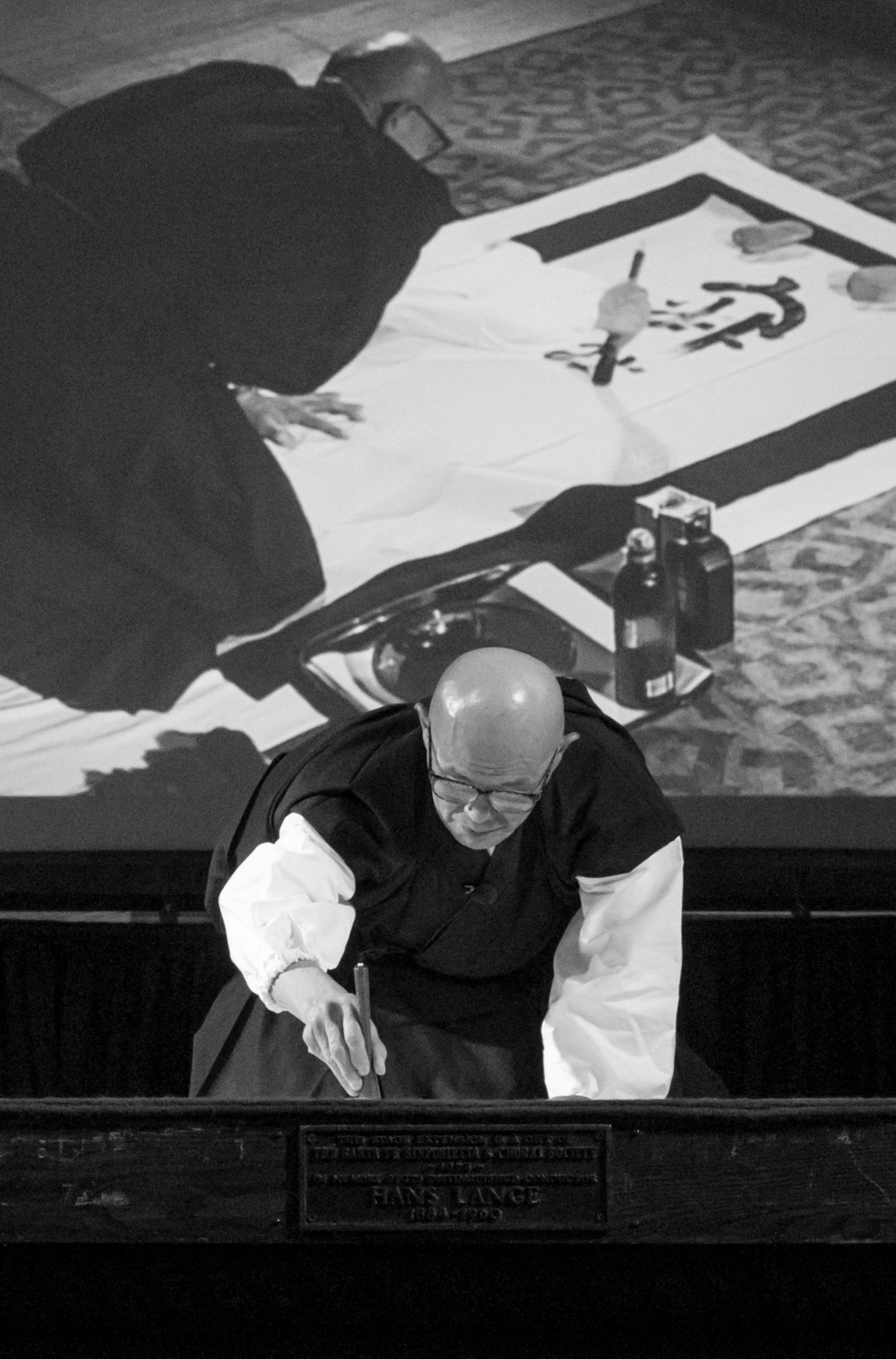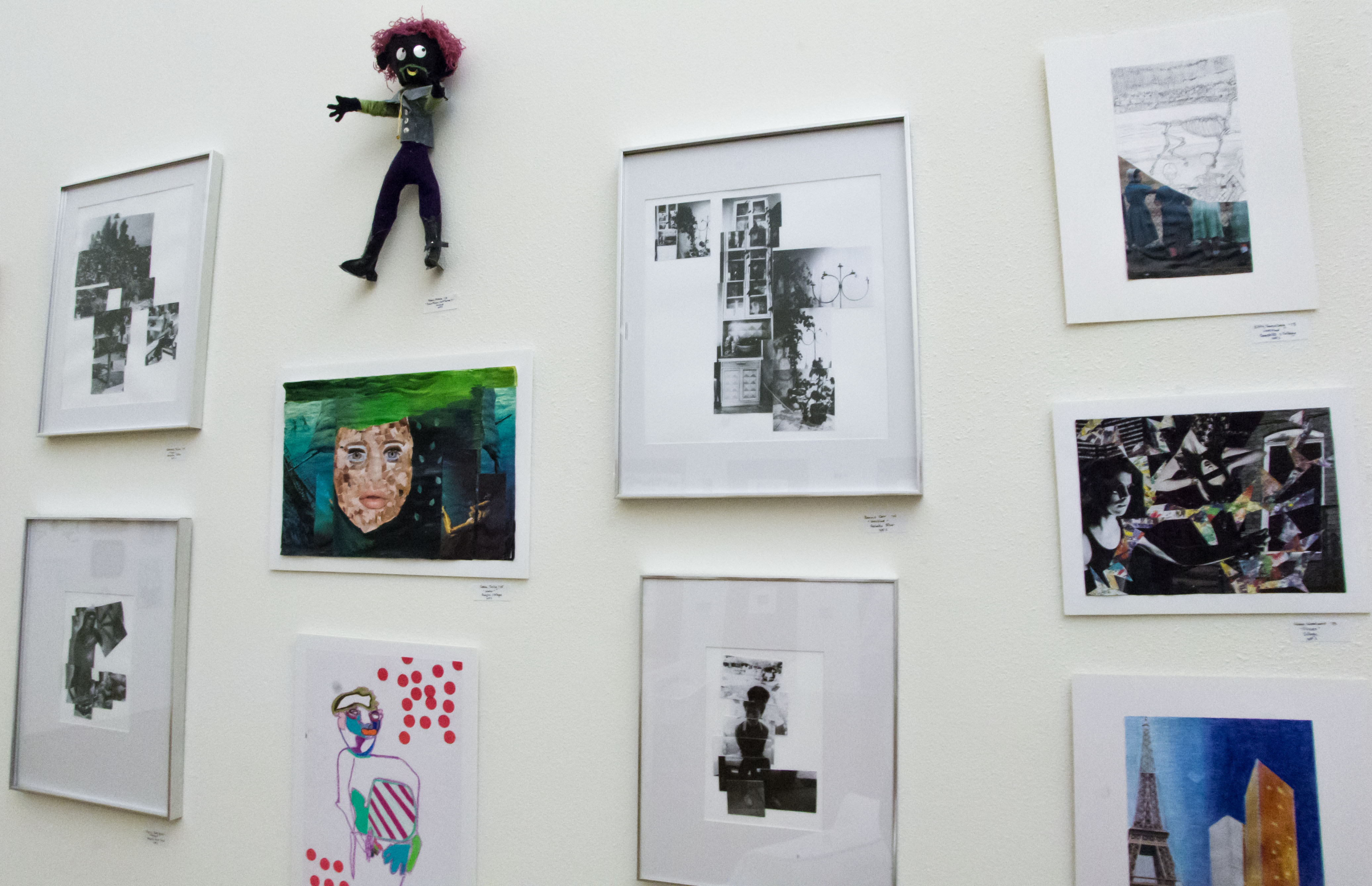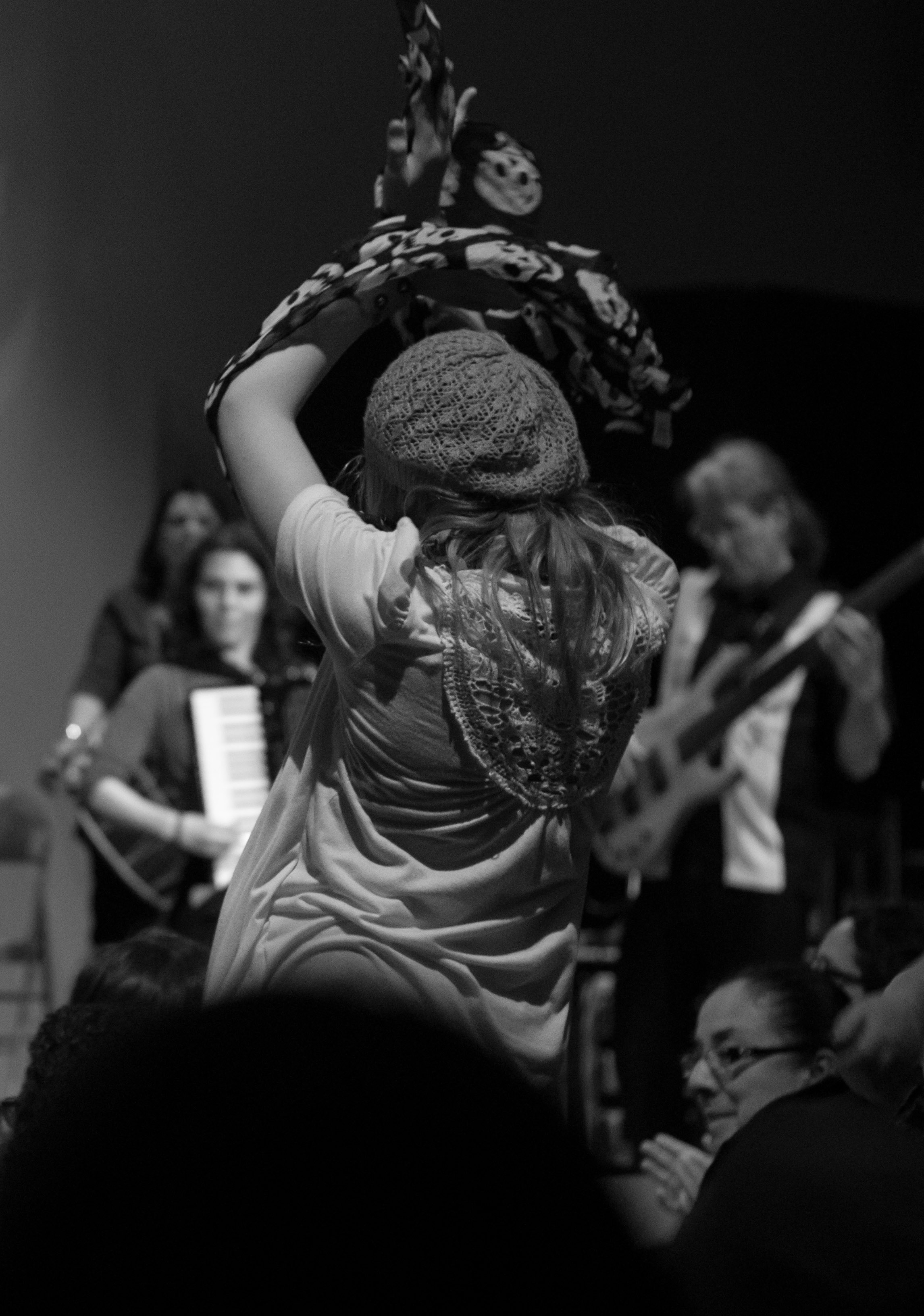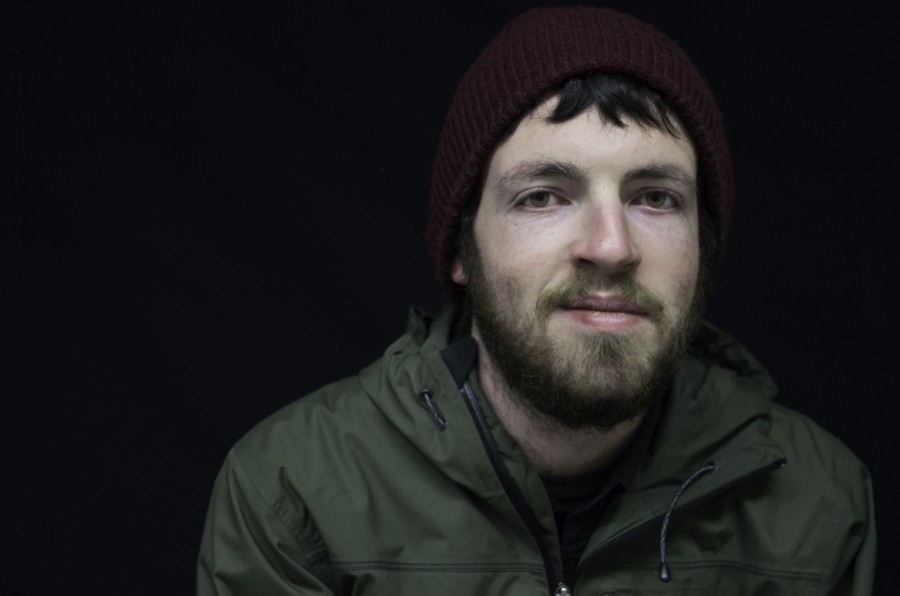By Charlotte Martinez/Photos by Natalie Abel From the wall paintings on St. Francis’s auditorium in downtown Santa Fe, an image of the catholic saint gazes with pastel eyes at the scene forming in the front of his pews. Three robed members of the Tahoma One Drop Zen Monastery from Whidbey Island are seated on the stage, peering indifferently at the audience as they file in. A fourth member stands, monitoring a pile of blank canvases and a bowl of black ink on the stage floor. Positioned in front of these tools is at camera that projects the image on a large screen. This, no doubt, is for the convenience of those audience members who just hate when they can’t see. Japanese Master Shodo Harada Roshi stands on Francis’s stage with his hands clasped against his long black robe. He, like the others, looks serene and statuesque in what I can only label as a zen zone, but looking at the wise wrinkles and slick head I can’t help but calculate the master’s age. If he was born in 1940, his face is that of a 73-year-old, but even this doesn’t seem right. His face is too shaped and his posture too perfect; could this be a side effect of a disciplined life? If I feel like shaking his hand to obtain wisdom, is that too “western” of me? His interpreter and facilitator, Daichi-Priscilla Storandt, sits next him with a kind-looking grin which contrasts the Roshi’s stoic one. If balance is essential in Buddhism, then the coupling is just short of perfect. Books on the Roshi’s calligraphy works are for sale in front and I wonder if St. Francis objects to this display. The Roshi perhaps feels this too, and despite his title, practice...
Monte Del Sol student work on display at SFUAD...
posted by Natalie Abel
By Arianna Sullivan/Photos by Natalie Abel The Marion Center is alive with a plethora of energy when I enter. A group of Monte del Sol Charter School students grouped in the corner of the main gallery sing energetically, accompanied by an electric keyboard. The walls are filled, seemingly top to bottom, with an eclectic mix of different mediums—from photography to 3-D dolls—all a product of the spirited Monte del Sol art department, and the efforts of its two key players: Michael Webb and Nancy Sue Michels. The place is absolutely swarming with middle and high school students, Santa Fe University students and faculty, parents of the Monte del Sol students, and even Santa Feans who came to the Marion Center to view the two other shows opening in the space, and then wandered into the charter school’s show with pleasantly surprised looks on their faces. When Natalie and I finally track down Michael and Nancy Sue, they are both buoyant and enthusiastic about the show, and the turn-out for its opening. “This might be the best show we’ve ever had,” they agree, referring to the success of the Marion Center as a space to showcase their students’ work after 13 years of working together to put up an annual show of the student work being created in Monte’s art department. Nancy Sue is excited, she explains, by the energy that is constantly buzzing about the Marion Center Gallery. “Even when we were hanging the show the other day,” she says, “there were people coming through here, going about their business. It’s not like a gallery space that closes up at night and after that nobody sees the artwork. Plus,” she concedes with an almost mischievous smile, “it gives me this little flashback to being...
15 Minutes of Hero Worship with Shepard Fairey
posted by Natalie Abel
Last week, internationally renowned graphic artist Shepard Fairey painted a mural at Santa Fe University of Art and Design. Most students here, including myself, eagerly awaited his arrival, posting Facebook statuses, and antagonizing friends at other colleges who didn’t have Shepard Fairey painting a mural there. I’m a big fan of Fairey’s work, especially his Obey campaign, and his uncompromising style, so I was looking forward to getting a picture or something with him. My excitement doubled when I managed to squeeze myself into Fairey’s busy schedule to secure an interview for my journalism class. Who needs a picture or an autograph when I can actually sit down and talk to the man? With all the excitement, though, came fear. What could a second- year art student ask Fairey that a seasoned journalist hadn’t already covered? All Monday, students gathered around Fairey, who was making tremendous progress on his black and red ode to art. Some managed to get pictures with him. Others got some Obey stickers autographed. Junior Randy Martinez even had the opportunity to assist Fairey with some of the stencil work. As long as Fairey was painting, there were no fewer than 20 students watching him work. I had class all day so I didn’t get to join them. However, I did overhear the Public Enemy and NWA that he was listening to while working, which took him from a man I admired to a man I thought was the coolest on the planet. The next day, photographer Natalie Abel and I waited patiently outside a conference room, conversing about how nervous we were for the interview. Finally, SFUAD’s PR official, Lauren Eichmann, called us into the room. Upon entering the room, my immediate thought was that despite us both being about 5’11,’’ Shepard Fairey is a short man. I don’t know what it is about celebrity that alters expectations but I expected him to be at least 7 feet tall. Fairey appeared tired, which made sense considering the cold temperatures outside and the many hours he had already spent on the mural. He was decked in apparel from his clothing line, which at first seems narcissistic, but upon further reflection, if I had my own clothing line I wouldn’t pay for clothes either. Natalie and I introduced ourselves to Fairey, who extended his paint-covered hand for a handshake. I was notified beforehand that once I was in the room I would need to wait my turn, as the Frontier blog had a conference call interview with Fairey first. Two Frontier bloggers from New Zealand interviewed Fairey for close to 40 minutes, asking him questions about his humble beginnings as an artist and about Shepard’s most famous work, The Obama Hope poster. Most of his answers one could find on his Wikipedia page, though it was interesting to hear him talk about obscure late 80’s album covers and the skateboard culture that influenced much of his early work. The Frontier bloggers thanked Fairey for his time, and Fairey returned their politeness before ending the call. I flipped through my notebook, nervous and trying to find the first question. Prominently displayed on the mural is the phrase “Make Art Not War,” so I figured I would start with what the phrase means to him and what he wanted it to mean for the students of SFUAD. “What I felt was the best approach, was something more open to interpretation,” Fairey said. “Something that was about looking at art as a positive alternative to war and how each person would use their art as an alternative to war is up to them. I see creativity leads to recognizing humanity in others, to be compassionate towards others.” That was a great answer to a question that I’m sure every media outlet had already asked him. Having asked one explicitly journalistic question that I probably could have written a serviceable...
Rumelia, Santa Fe, Improv...
posted by Natalie Abel
There is no sound. It is the CD release party of Rumelia, Santa Fe’s Balkan music group, and there is no sound. The members of Santa Fe University of Art and Design’s Balkan Music Ensemble, who have been invited as guests to this event, loiter on the Railyard Performance Center’s makeshift stage of rugs and platforms on the hardwood dance floor. “How are we?” asks Polly Tapia Ferber, the director of the ensemble. “Are we good?” The audience is restless and ready, but a shout from the sound techies makes it clear that they are going to have to wait for just “one more second.” “Well,” says Polly, “We’ve been here for hours trying to make sure this wouldn’t happen, but…” She wanders off in search of technical solutions for the lack of sound coming from the ensembles’ microphones. Rumelia’s Nicolle Jenson, a College of Santa Fe alum, comes to the stage to announce that, “it’s a good thing we have a few tricks up our sleeve!” The group of three female artists joins her to perform two pieces a cappella. The women are performing this evening to celebrate the release of their CD ‘Lost and Found,’ but it is clear that they hardly need their instruments and a recording studio to capture the odd-time signatures and tonalities of the Balkan region of Eastern Europe. Using nothing but their lungs as instruments, they weave their voices together and immediately capture the audience’s revered attention. When they finish Polly is still scurrying back and forth across the stage checking wires in an attempt to make everything come together. On stage, just a handful of members of the ensemble lounge with their instruments. The sound problem will be figured out eventually, but this is Santa Fe,...
Breaking Barriers
posted by Natalie Abel
Story by Arianna Sullivan/Photo by Natalie Abel “Really,” says Tony O’Brien earnestly, “enjoy the photography. Be who you are.” The Santa Fe University Photographic Society meeting is still for a moment, digesting, and then works itself back up into the excited planning frenzy that preceded Tony’s statement. “So what are we photographing,” inquires one student eagerly, “the people, the streets, of just everything?” Tony looks at the array of confused, enthused and jittery faces and responds simply, “as you see it.” The group has gathered to discuss the Santa Fe Grid Project—the photo department’s plan for involvement in this year’s Outdoor Vision Fest. Outdoor Vision Fest is an annual outdoor art show of design, animation, video, photography and other visual imagery, and the photo department is preparing to be a larger and louder presence in 2013 than it has been in past years. The project that the photo department has decided to embark upon, the Santa Fe Grid Project, has potential to grow in influence beyond the festival and even the campus as well. The Grid Project, brainchild of Photography freshman Chris Beran, will be a photographic documentation of Santa Fe’s neighborhoods by SFUAD Photo Society members. Photo students from the school will document designated neighborhoods of the city by means of whatever photographic medium speaks to them—be it still image, analog or digital, time lapse, alternative processing, with or without the accompaniment of interviews or music—as Tony O’Brien puts it, “as you see it.” Both Chris Nail and Tony O’Brien, the faculty members heralding the Photo Department’s involvement in OVF 2013, are enthusiastic about the project’s potential to be the beginning of a continued relationship between SFUAD and the city of Santa Fe. “It will be a living document, a sort of micro-version...
Breaking Barriers
posted by Natalie Abel
Story by Arianna Sullivan/Photo by Natalie Abel “Really,” says Tony O’Brien earnestly, “enjoy the photography. Be who you are.” The Santa Fe University Photographic Society meeting is still for a moment, digesting, and then works itself back up into the excited planning frenzy that preceded Tony’s statement. “So what are we photographing,” inquires one student eagerly, “the people, the streets, of just everything?” Tony looks at the array of confused, enthused and jittery faces and responds simply, “as you see it.” The group has gathered to discuss the Santa Fe Grid Project—the photo department’s plan for involvement in this year’s Outdoor Vision Fest. Outdoor Vision Fest is an annual outdoor art show of design, animation, video, photography and other visual imagery, and the photo department is preparing to be a larger and louder presence in 2013 than it has been in past years. The project that the photo department has decided to embark upon, the Santa Fe Grid Project, has potential to grow in influence beyond the festival and even the campus as well. The Grid Project, brainchild of Photography freshman Chris Beran, will be a photographic documentation of Santa Fe’s neighborhoods by SFUAD Photo Society members. Photo students from the school will document designated neighborhoods of the city by means of whatever photographic medium speaks to them—be it still image, analog or digital, time lapse, alternative processing, with or without the accompaniment of interviews or music—as Tony O’Brien puts it, “as you see it.” Both Chris Nail and Tony O’Brien, the faculty members heralding the Photo Department’s involvement in OVF 2013, are enthusiastic about the project’s potential to be the beginning of a continued relationship between SFUAD and the city of Santa Fe. “It will be a living document, a sort of micro-version of the documentation that occurred during the American Depression,” explains Chris Nail, “an evolving picture history of the city.” Tony O’Brien brings attention to the gap that usually exists between universities and the cities they are planted in, with a hopeful sense that this project could bridge that gap between the Santa Fe community and the Santa Fe University. If the project is repeated every year as a sort of series, O’Brien explains, the relationship would be symbiotic—the students would be given an opportunity to extend their tromping grounds beyond the school campus, meanwhile providing a sort of service to Santa Fe. This hope is mirrored by the enthusiasm of the students already involved in the project. Chris Beran, who got the idea for the grid project from a similar one in Portland, says that he’s inspired by the opportunity to give back to the community in an artistic way. “Community service is awesome,” he says, “but it’s kind of generic. But if you can use your skills and really put time and effort into something and give it back with that—to me, that’s priceless.” Chris is aware that there are challenges to large-scale community oriented projects like this, but he is confident that the artistic drive behind each photographer will carry the project forward. “It’s just a matter of finding the time, getting out there, and doing it,” he says enthusiastically. The reality of this hits home as, back at the Photo Society meeting, students begin to chart out the neighborhoods they will be documenting—first with a calling out of street names accompanied by exuberant hand gestures, and then more concretely with a map of the city in front of them. Confusions arise, and the largeness of the project sinks in; “Oh- saj? Where the hell is oh-saj?” asks one student, mispronouncing the street name. Laughter resounds, and somebody chirps up, “I think it’s called Osage.” “Wow,” exclaims another, somewhat startled student, viewing her neighborhood on the map for the first time, “that is a huge chunk of Alameda!” Tony and Chris eyeball each other with eyebrows raised, all too aware of the reality...






 Jackalope Magazine is the student magazine of Santa Fe University of Art and Design. Building on the interdisciplinary nature of our education, we aim to showcase the talent of our university and character of our city.
Jackalope Magazine is the student magazine of Santa Fe University of Art and Design. Building on the interdisciplinary nature of our education, we aim to showcase the talent of our university and character of our city.
Recent Comments